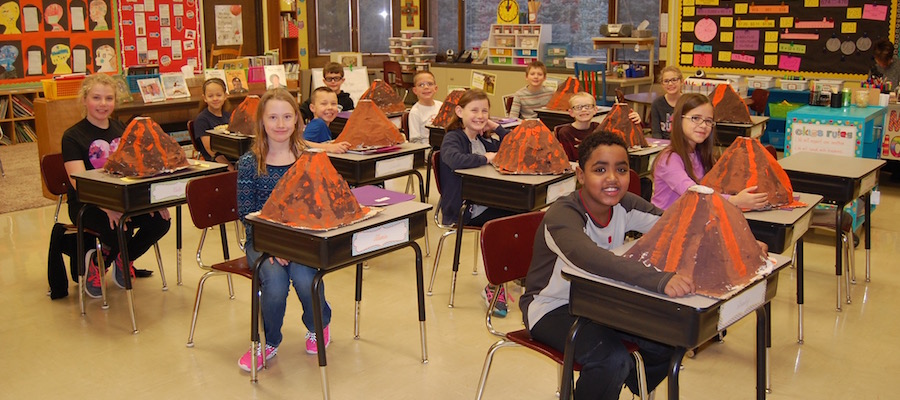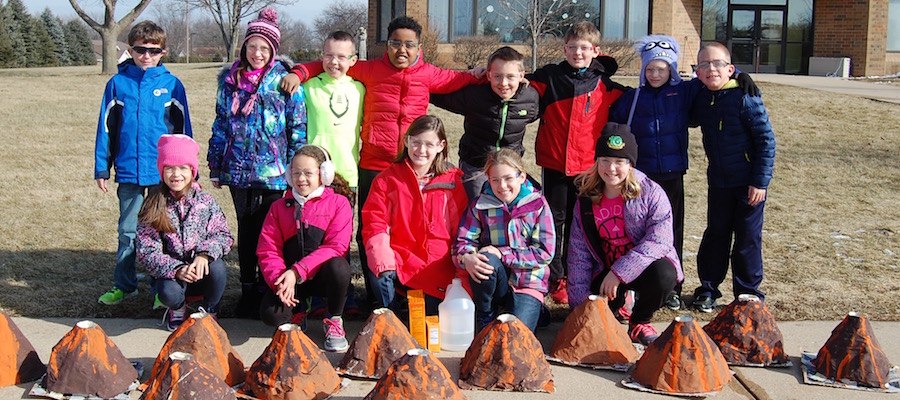2017-2018
4th Grade Microscope Lab
Dr. Emily Lehman, professor at Blackhawk College and St. Malachy parent, visited 4th grade. Students moved from station to station to view various slides with microscopes and record their observations.
2nd Grade Pumpkins
Mrs. Heidi Frank visits 2nd grade to share her expertise on growing pumpkins.
6th Grade Can Crushers
5th Grade Genius Hour
Spaghetti Marshmallow Towers
Make-Your-Own Newspaper Shoes
2nd Grade Robots
6th Grade Earthworm Observation Lab
Sixth graders dig into science with an earthworm observation lab. A packet of information provided background knowledge for the students to generate hypotheses about the worms' reaction to environmental stimuli. Students gathered data about their worms measuring their length and observing their movements.
Student Observations
2016-2017
5th & 6th Grade Rockets
Fifth and sixth grade students build and launch rockets each spring. The fifth graders learn to read and follow directions and work independently as they all assemble the same rocket. Sixth graders "shop" and choose their own rocket model. The step by step assembly of the rockets proves challenging for some, but it's worth the hard work to see the rockets launched into the sky!
Guest Teacher Bugs Students with Science
Emily Lehman, Ph.D. guest taught exciting science lessons for third, fifth and sixth grades. Dr. Lehman earned a Bachelor's degree in Biology with a minor in Chemistry from the University of Northern Iowa and went on to attend graduate school in the Department of Genetics at Case Western Reserve University in Cleveland, Ohio where she earned a Ph.D. in Genetics and studied genetic modifiers of Alzheimer's Disease. She worked as an adjunct professor in Biology at the University of Northern Iowa before joining the faculty in the Natural Sciences and Engineering Department at Black Hawk College in Moline, Illinois in 2006. Dr. Lehman has the pleasure of teaching a variety of biology courses including General Biology, Human Biology, Genetics, Microbiology and Nutrition at Black Hawk College. The Lehman family lives in Geneseo and all three of their children have attended St. Malachy School.
6th Grade Genetics Lab
6th grade investigated Mendelian genetic crosses using fruit flies. The class observed wild type and two types of mutant flies. Students made predictions about the offspring that would be produced in crosses of red eye and white eye flies. Lab groups counted offspring flies, collected class data, and students decided whether the hypotheses they had made were supported by the data. The Punnet square was introduced as a method to predict offspring in crosses.
3rd Grade Beetle Lab
The class studied the carrying capacity of Bess bugs, a large, docile beetle. Students observed the anatomy of the Bess bug, took length and weight measurements and made predictions about how much weight their Bess could pull. Students counted the number of nickels the Bess bug could pull and calculated the percentage of its weight the Bess bug pulled.
5th Grade Pill Bug Lab
The class used to scientific method to address questions about pill bug behavior. Students observed the anatomy and behavior of pill bugs. The class formulated hypotheses regarding pill bug choice of moist or dry, light or dark and sand or soil. Choice chambers were used to count the amount of pill bugs in either environment over time. Class data was tabulated and students decided whether their hypothesis was supported or rejected by the data.
3rd Grade Volcanoes
After studying volcanoes in science class third grade constructed their own volcanic mountains out of Pringles cans and paper mache. Students erupted with enthusiasm for science as they watched the chemical reaction that occurs when mixing baking soda and vinegar!


5th Grade World in Motion
St. Malachy 5th graders learned to think like engineers during their “World in Motion” unit. The end result of each group’s effort was a balloon-powered car that the students had to test, measure the distance traveled and adjust if needed. Mr. Barry Hager, a St. Malachy parent and engineer at John Deere, guest taught several lessons introducing the students to the wide variety of opportunities in the field of engineering. Mr. Hager earned a degree in Ag Systems Technology at Iowa State and an MBA from the University of Iowa. He is the Manufacturing Engineering Manager at John Deere Harvester Works in East Moline. In his 18 years at John Deere he has worked at 6 different sites supporting manufacturing engineering efforts for production of large construction and ag equipment.
6th Grade Can Crushers
One of the most eagerly anticipated activities of sixth grade requires students to apply knowledge of simple machines and collaborate in small groups to design and assemble working can crushers. Each group may include up to six different simple machines in the design of their can crushers including a fulcrum, inclined plane, lever, pulley, screw and wedge.
5th Grade Bridge Building
Working in small groups, fifth graders are challenged to design and build a bridge using toothpicks and gummy pumpkin candies. Creating a solid structure from such limited materials is challenge enough; and working collaboratively requires students to communicate effectively, respect others' ideas and exercise self-control as they compromise and choose a course of action that best suits the needs of the entire group.
Extending the activity one step further, students work in new groups to build a second bridge using foam, rubber bands, string and glue. A new group, along with different materials, make the "same assignment" completely new.
2015-2016
5th Grade Pill Bug Observation Lab
Dr. Emily Lehman, Professor of Biology at Blackhawk College, visited St. Malachy School to guest teach a pill bug observation lab in fifth grade.
6th Grade Can Crushers
Sixth graders put their engineering skills to the test as they work in groups to design and build a working can crusher. Students may include up to six different simple machines in the design of their can crushers including a fulcrum, inclined plane, lever, pulley, screw and wedge.
3rd Grade Volcanoes
Using Pringles chips cans, crumpled newspaper, and masking tape students build the base structure for their volcanic mountains, then cover them in papier mache. Once the volcanoes have dried, students paint them before erupting them.
Students experimented with two different methods to erupt their volcanoes. Some students used baking soda, red food coloring and vinegar to create a bubbling lava flow while others tested a new method dropping Mentos mints into bottles of Diet Coke. The mints and soda did not create as much of an eruption as the baking soda and vinegar. Students hypothesized that they might get a better reaction using a larger bottle of soda.
5th & 6th Grade World In Motion
The fifth and sixth grade students explore topics in engineering during the "World in Motion" unit. Mr. Nate Mariman and Mr. Jon McAvoy, engineers who work at John Deere, engaged in discussion with the students introducing them to the many different opportunities in the field of engineering. Students learned about the importance of sharing ideas with others before breaking into groups to construct a car powered by a balloon.
6th Grade Owl Pellet Dissection
Sixth grade learns about the diet of owls as they dissect owl pellets. After an owl eats the small rodents, birds and bugs that make up the majority of its diet, its stomach cannot digest the fur, bones, teeth, feathers and insect shells from their meals. These "extra" parts are formed into a tight pellet and later spit up by the owl.
5th Grade Student Choice STEM Projects
Fifth Graders worked in small groups during the second quarter to explore a variety of STEM activities. Projects included "Fireworks in a Jar", "Walking Water", "CD Hover Crafts", "Power of the Pennies" home-made battery, and building a working hydraulic bridge arm!
3rd Grade Butterflies
Third grade follows the life cycle of butterflies, carefully documenting and keeping journals about the physical changes of their caterpillars. Once the butterflies emerge from their chrysalis, students have the opportunity to spend time observing their behavior in the butterfly tent before releasing them into the wild.
Click on the links below to read the students' observation journal entries.
2nd Grade Robots
Second graders worked in groups to invent an original robot. They brought their imagination to life constructing their robots from a variety of materials. Students were forced into strategic problem solving situations as they faced structural issues, such as robots tipping over, during the building process. Each team had to be flexible and willing to make changes to their original designs as problems arose and they generated and tested possible solutions.
Each group of students presented their completed robot to the class...
5th Grade Spaghetti Marshmallow Towers
Fifth Grade students work in groups to build the tallest structure using uncooked spaghetti noodles and marshmallows.
6th Grade Earthworm Observation Lab
Sixth graders employ the scientific method and keen observation skills to learn more about earthworms.
1st Grade All About Apples
First graders use math skills to estimate weight and measure the size of apples. They rely on their senses as they touch, smell and taste different varieties of apples then graph the results of the class' favorite apples.